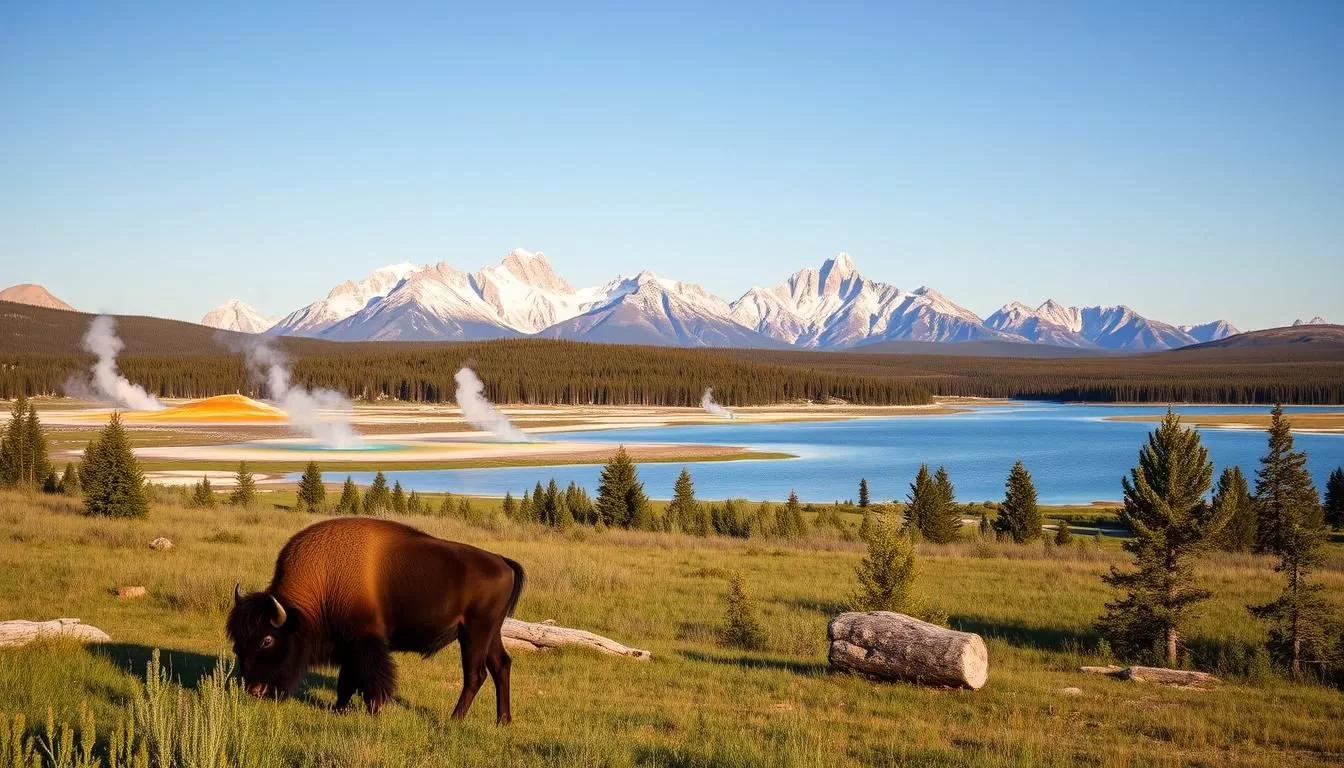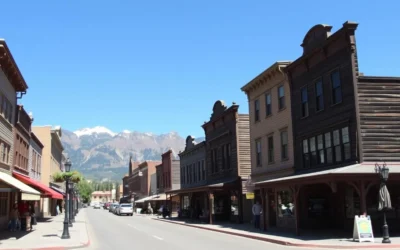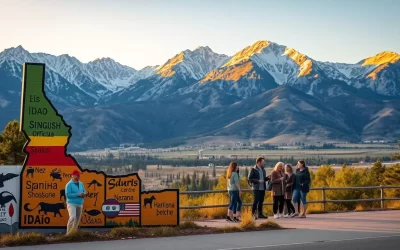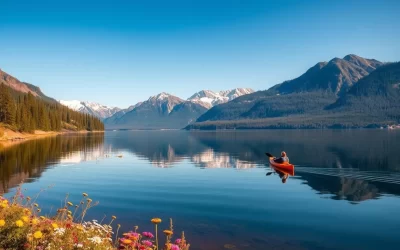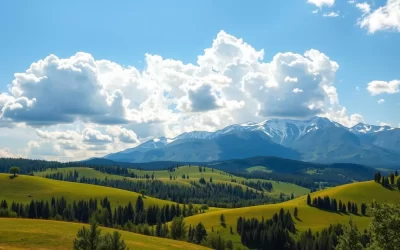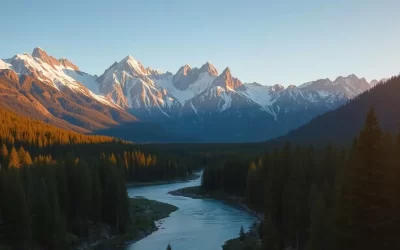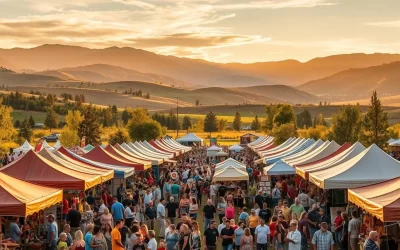Imagine standing amidst geothermal wonders and diverse wildlife, surrounded by the towering peaks of the Absaroka-Beartooth Mountains. Yellowstone National Park is a world-renowned destination that invites you to explore its vast wilderness.
As America’s first national park, it spans across three states, offering a unique combination of geothermal features, wildlife viewing opportunities, and stunning landscapes. With 2.2 million acres to explore, planning a trip can be overwhelming.
This guide is designed to help you navigate the park’s vast area and experience the top attractions. Based on firsthand experience and local knowledge, our curated list represents the must-see experiences that you shouldn’t miss, even on a shorter visit.
Discovering the Wonders of Yellowstone National Park
As you step into Yellowstone National Park, you’ll discover a world of natural wonders. With over 10,000 thermal features and more than half of the world’s active geysers, this park is a true marvel. The park’s rich history, diverse wildlife, and stunning landscapes make it a must-visit destination for any traveler.
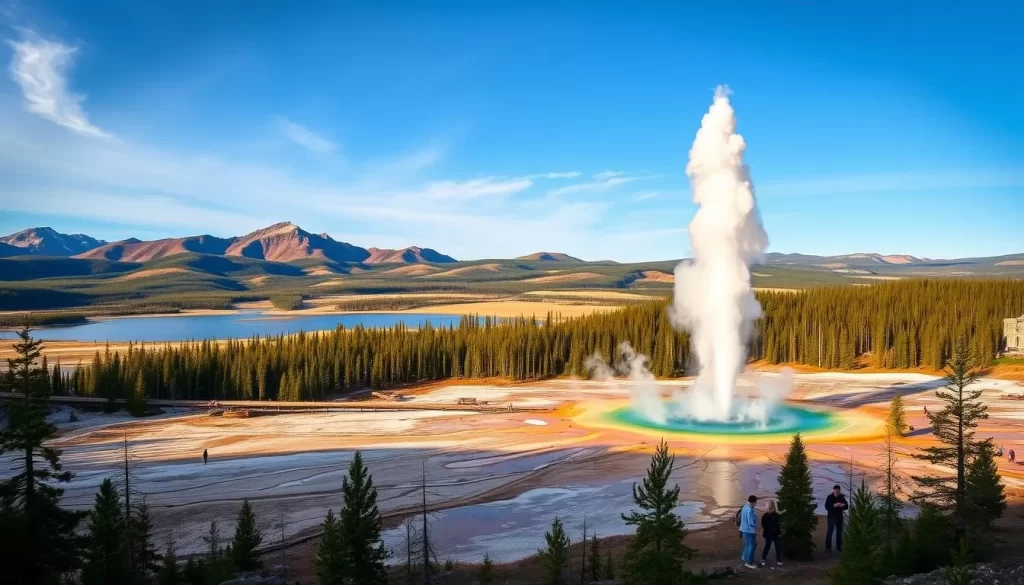
Why Yellowstone Should Be on Your Bucket List
Yellowstone stands as a unique natural wonder, boasting an unparalleled concentration of geothermal features. The park’s historical significance as America’s first national park, established in 1872, has helped launch the global conservation movement. With its diverse wildlife, including grizzly bears, wolves, and elk, Yellowstone is a nature lover’s paradise.
The park’s geothermal features, such as Old Faithful and the Grand Prismatic Spring, are a major draw for visitors. The park’s diverse landscapes, including hot springs, geysers, and waterfalls, make it a photographer’s dream destination.
Best Time to Visit and Planning Your Trip
When planning your trip to Yellowstone, it’s essential to consider the best time to visit. Summer (June-August) offers full access to the park, but it also means larger crowds. Spring and fall provide fewer visitors, but the weather conditions can be variable.
To make the most of your visit, plan to stay for at least 4-5 days to properly experience the park’s major regions. It’s also recommended to secure accommodations well in advance (6-12 months) for in-park lodging or explore nearby towns like West Yellowstone for alternatives.
Creating a flexible itinerary that groups attractions by geographic area will help minimize driving time between distant points in the park. The West Entrance is the most popular entry point for first-time visitors due to its proximity to major attractions.
Essential Tips for Visiting Yellowstone National Park
To make the most of your Yellowstone National Park adventure, it’s essential to grasp the park’s layout and plan accordingly. Spanning over 2.2 million acres, Yellowstone is a vast wilderness area with diverse attractions.
Navigating the Park’s Size and Layout
The park is connected by the Grand Loop Road, a figure-eight pattern that links major attractions. Understanding this layout is crucial for navigating between the park’s distinct regions. Driving times between attractions can be longer than expected, so it’s vital to plan your day accordingly.
- The Grand Loop Road covers approximately 142 miles, with various entrances and exits.
- Estimated driving times between major attractions should be considered when planning your itinerary.
Parking and Traffic Considerations
Parking at popular sites has become a significant issue due to high crowds. To avoid congestion, consider arriving early, before 8 am, or visiting popular sites in the evening. You can check real-time updates on parking availability and traffic conditions on the Yellowstone National Park website.
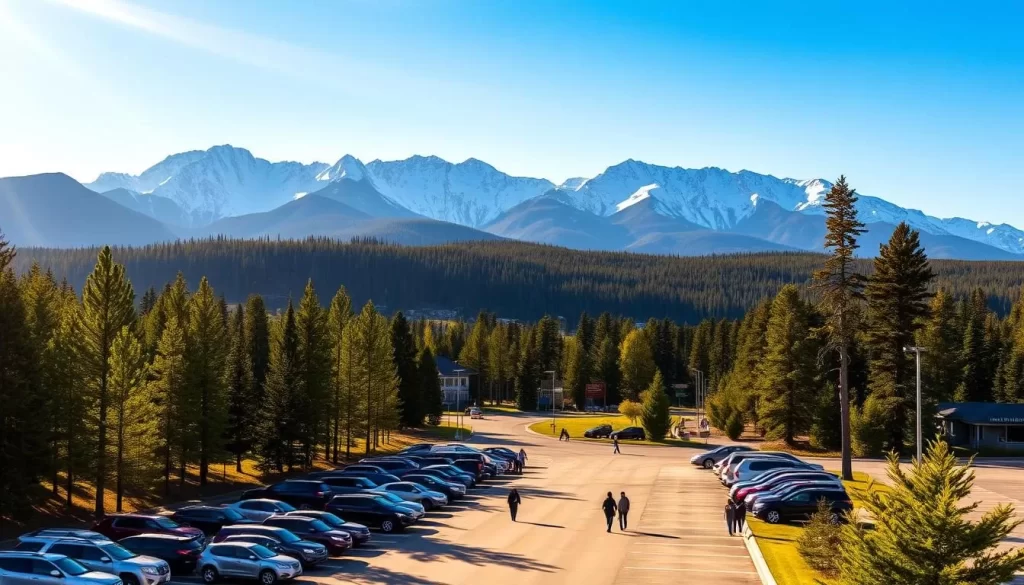
Wildlife Safety Guidelines
Maintaining a safe distance from wildlife is crucial. Keep at least 100 yards from bears and wolves, and 25 yards from other wildlife. Avoid feeding wildlife, as it’s strictly prohibited and dangerous for both animals and people. When hiking, make sure to carry bear spray and know how to use it properly.
By following these guidelines, you can ensure a safe and enjoyable visit to Yellowstone National Park.
Old Faithful and Upper Geyser Basin
The Upper Geyser Basin, home to the iconic Old Faithful, is a must-visit destination for anyone exploring Yellowstone National Park. This area is renowned for its high concentration of geothermal features, including geysers, hot springs, and thermal pools.
Witnessing the Famous Old Faithful Eruption
Old Faithful is Yellowstone’s most iconic attraction, erupting approximately every 90 minutes, with heights ranging from 100 to 185 feet. To make the most of your visit, check the predicted eruption times at the visitor center and arrive 20-30 minutes early to secure a good viewing spot. For a less crowded experience, consider hiking the Observation Point Trail.
Exploring the Historic Old Faithful Inn
The Old Faithful Inn, built in 1904, is a masterpiece of rustic architecture and one of the largest log structures in the world. Take a free ranger-led tour to discover its unique features, including the massive stone fireplace and the historic “Crow’s Nest.”
Upper Geyser Basin Highlights
The Upper Geyser Basin is a geothermal wonderland, boasting over 150 features within a square mile. Some of the must-see attractions include:
Morning Glory Pool
Located 1.5 miles from Old Faithful, the Morning Glory Pool is a vibrant hot spring known for its stunning blue, yellow, and orange hues. Unfortunately, its beauty has been somewhat diminished by visitor vandalism over the years.
Castle Geyser and Grotto Geyser
Castle Geyser features a 12-foot sinter cone that resembles a castle turret, while Grotto Geyser’s unique formation is a result of minerals depositing around trees. These geysers are a testament to the natural wonders that can be found in the Upper Geyser Basin.
To maximize your experience, plan your walking route through the basin carefully to minimize backtracking and enjoy the various geothermal features at your own pace.
Grand Prismatic Spring and Midway Geyser Basin
The Grand Prismatic Spring, with its diverse microbial life, creates a natural spectacle that attracts visitors from around the world. As the largest hot spring in the United States, it is a must-see attraction in Yellowstone National Park.
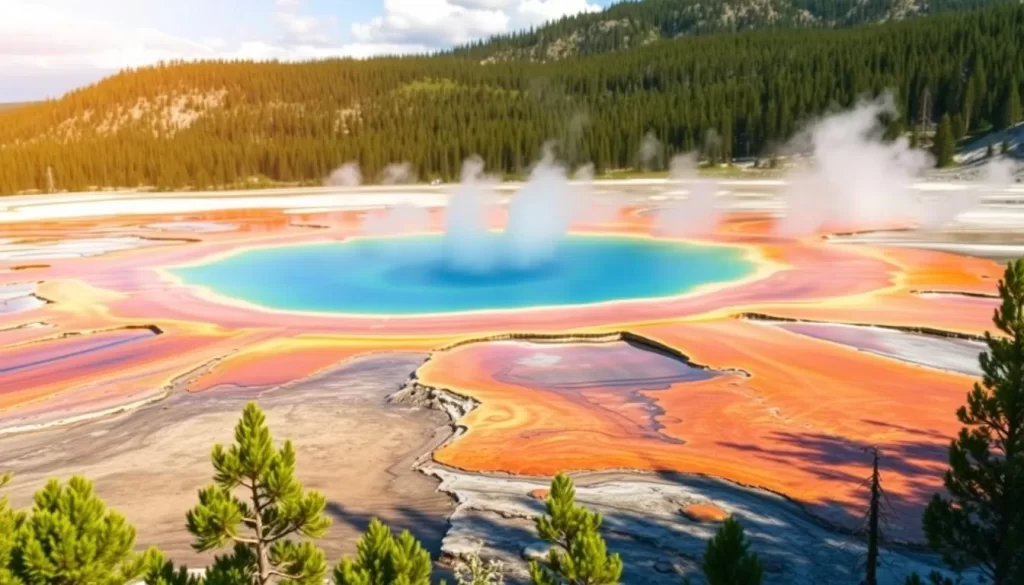
Walking the Midway Geyser Basin Boardwalk
As you walk along the Midway Geyser Basin boardwalk, you’ll be treated to a variety of geothermal features, including Excelsior Geyser Crater, Turquoise Pool, and Opal Pool, before reaching the Grand Prismatic Spring. This 0.4-mile walk is a journey through some of Yellowstone’s most stunning geothermal landscapes.
The boardwalk is designed to provide easy access to these natural wonders while minimizing the impact on the fragile ecosystem. Be sure to stay on the designated paths to preserve the area and ensure your safety.
Grand Prismatic Spring Overlook Trail
For a more panoramic view of the Grand Prismatic Spring, consider hiking the Grand Prismatic Spring Overlook Trail, a 1.6-mile round-trip journey from the Fairy Falls parking lot. This trail offers an elevated perspective of the spring, capturing the full majesty of this natural wonder.
The trail is moderately difficult, but the reward is well worth the effort, providing a unique and breathtaking view that is perfect for photography.
Best Time to Visit for Optimal Colors
Visiting the Grand Prismatic Spring at midday on a sunny day offers the most vibrant colors, as the morning fog has lifted and the afternoon shadows have not yet obscured the view. Be aware that this is also the busiest time, so plan accordingly.
The colors of the spring vary with the seasons, with summer showcasing more orange and red hues, while spring and fall tend to display more green and blue tones. Understanding these variations can help you plan your visit for the best viewing experience.
To capture the beauty of the Grand Prismatic Spring, consider using a polarizing filter on your camera lens to reduce glare and enhance the colors. The optimal camera settings will depend on the lighting conditions, but a low ISO and a small aperture can help achieve the best results.
Yellowstone National Park, Idaho: Best Things to Do – Top Picks for Wildlife Viewing
The diverse ecosystem of Yellowstone National Park makes it an ideal location for observing a wide range of wildlife. With its intact ecosystem supporting diverse species, including bison, elk, wolves, bears, and more, Yellowstone offers some of the best wildlife viewing opportunities in North America.
Lamar Valley: The Serengeti of North America
Lamar Valley is hailed as the best spot to view wildlife in Yellowstone, earning it the nickname “America’s Serengeti.” This valley is particularly known for wolf watching since their reintroduction in 1995. Visitors can expect to see bison, elk, pronghorn, bear, coyotes, and wolves. The best times for wildlife viewing in Lamar Valley are during the morning and evening.Early risers and those who stay out late are rewarded with the most significant wildlife encounters.
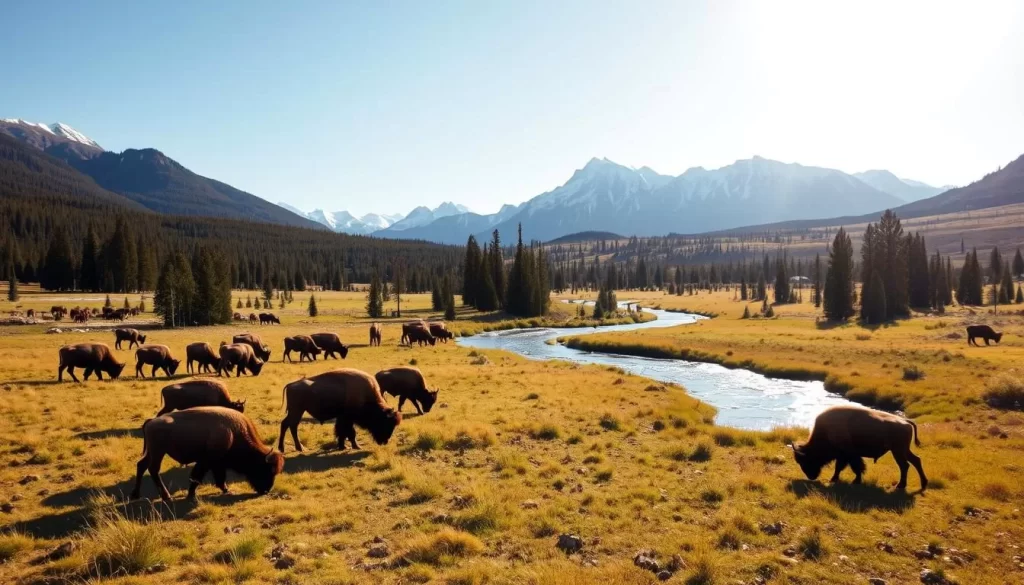
Hayden Valley Wildlife Spotting
Hayden Valley is another excellent location for wildlife viewing, located between the Grand Canyon of the Yellowstone and Yellowstone Lake. This area is more centrally located and accessible, making it ideal for visitors with limited time.Bison are commonly spotted here, and the valley offers a chance to see these magnificent animals up close.
Wildlife Photography Tips
For those interested in capturing the wildlife on camera, using a telephoto lens (at least 300mm) is recommended. Adjusting camera settings for low light conditions and practicing ethical photography that doesn’t disturb animals are also crucial.Maintaining a safe distance and being patient will result in better photography outcomes.
To maximize your wildlife viewing experience, consider visiting during the optimal seasons: spring for baby animals and fall for the elk rut. Bringing binoculars or a spotting scope can enhance your viewing experience. Look for clusters of parked vehicles, as they often indicate wildlife sightings. Always maintain proper distances: 100 yards from predators and 25 yards from other wildlife.
The Grand Canyon of Yellowstone
With its stunning vistas and geological significance, the Grand Canyon of Yellowstone is a highlight of the Yellowstone National Park. The canyon, carved by the Yellowstone River over thousands of years, stretches roughly 20 miles long and reaches depths of up to 1,200 feet. The walls of the canyon are painted in stunning yellows, pinks, and oranges due to hydrothermal alterations.

North Rim Highlights
The North Rim of the Grand Canyon offers breathtaking views and unique experiences. One of the main attractions is the Brink of the Lower Falls trail, which takes you to the edge where the 308-foot waterfall plunges into the canyon.
Brink of the Lower Falls
To reach this viewpoint, you’ll embark on a nearly half-mile walk downhill, followed by a strenuous walk back up with 600 feet of elevation gain. The effort is worth it for an up-close view of the Lower Falls as it thunders over the edge.
Lookout Point
Another highlight of the North Rim is Lookout Point, which offers a comprehensive view of the Lower Falls. You can also descend to Red Rock Point for a closer view.
South Rim Must-See Spots
The South Rim is home to some of the most iconic viewpoints in the Grand Canyon of Yellowstone. Artist Point is a crown jewel, offering the most photographed view of the Lower Falls framed by the colorful canyon walls.
Artist Point
To experience this iconic view, park in the large parking lot and take a short walk to the overlook. It’s a perfect spot to capture the beauty of the canyon.
Uncle Tom’s Trail
Although currently closed, Uncle Tom’s Trail is historically significant as it once descended 328 steps to provide a view from near the base of Lower Falls.
Photography Tips for Canyon Views
To capture the best views of the Grand Canyon, consider the time of day. Morning is ideal for Artist Point, while the afternoon is better for North Rim views. Use the right equipment and composition to enhance your photography experience.
Best Hiking Trails in Yellowstone
With its vast wilderness and varied landscapes, Yellowstone National Park is a hiker’s paradise. The park offers a diverse range of hiking trails that cater to all fitness levels and interests, from easy boardwalk strolls to challenging mountain ascents.
You can explore the park’s natural beauty through its many hiking trails, designed to suit every ability. Whether you’re looking for a leisurely walk or an adventurous climb, Yellowstone has something for everyone.
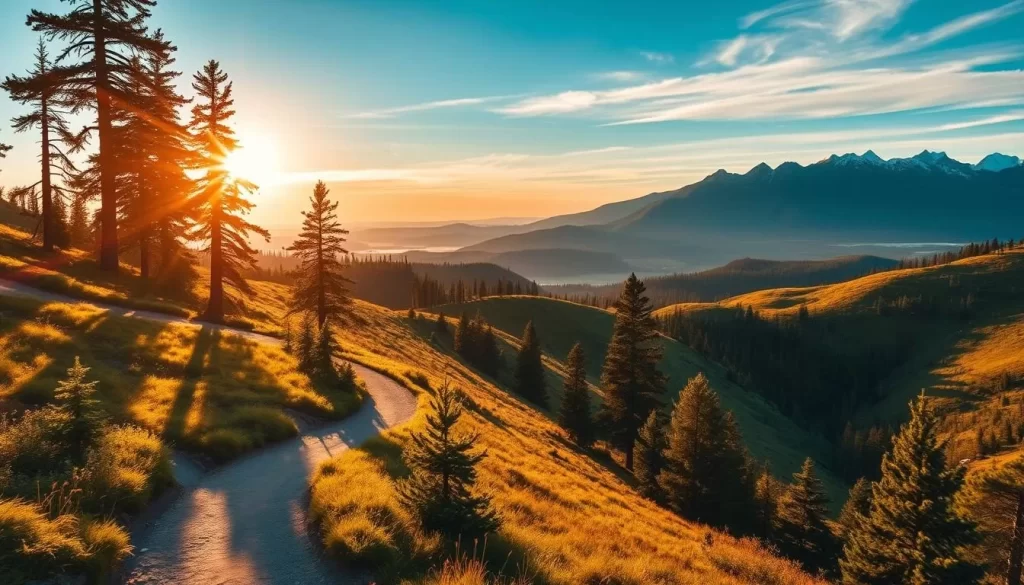
Fairy Falls Trail
The Fairy Falls Trail is a moderate 5.4-mile round-trip hike that leads to a stunning 200-foot waterfall. This trail is considered easy and is a great option for those looking to experience one of Yellowstone’s tallest waterfalls. You can start from the Fairy Falls parking lot, which is the same parking lot used to visit the Grand Prismatic Spring Overlook. Most of the hike is through a lodgepole forest, and you might encounter bear and other wildlife on the trail.
Mount Washburn Trail
For panoramic views of Yellowstone National Park, hike to the peak of Mt. Washburn. This is one of the most popular day hikes in the park, with two route options: the Dunraven Pass Trailhead on Grand Loop Road (6.2-mile round trip) or Chittendon Road (5-mile round trip). The summit offers 360-degree views and the possibility of spotting bighorn sheep.
Storm Point Trail
The Storm Point Trail is an ideal family-friendly option, offering a 2.3-mile round-trip hike that combines lakeside views, forest sections, and meadows with minimal elevation gain. This trail is suitable for hikers of all ages and abilities.
Avalanche Peak Trail
For serious hikers, the Avalanche Peak Trail offers the best alpine experience in Yellowstone. This challenging 4.5-mile round-trip climb rewards you with spectacular views at 10,566 feet. It’s essential to be prepared with the right gear and to hike in groups.
When hiking in Yellowstone, it’s crucial to carry bear spray, hike in groups of three or more, make noise in dense areas, and bring appropriate gear. Seasonal considerations are also important, as high-elevation trails like Mount Washburn and Avalanche Peak are typically snow-free only from mid-July through September.
Other noteworthy trails in Yellowstone include Bunsen Peak, Elephant Back Mountain, and Observation Point, offering additional hiking options for visitors.
Mammoth Hot Springs Area
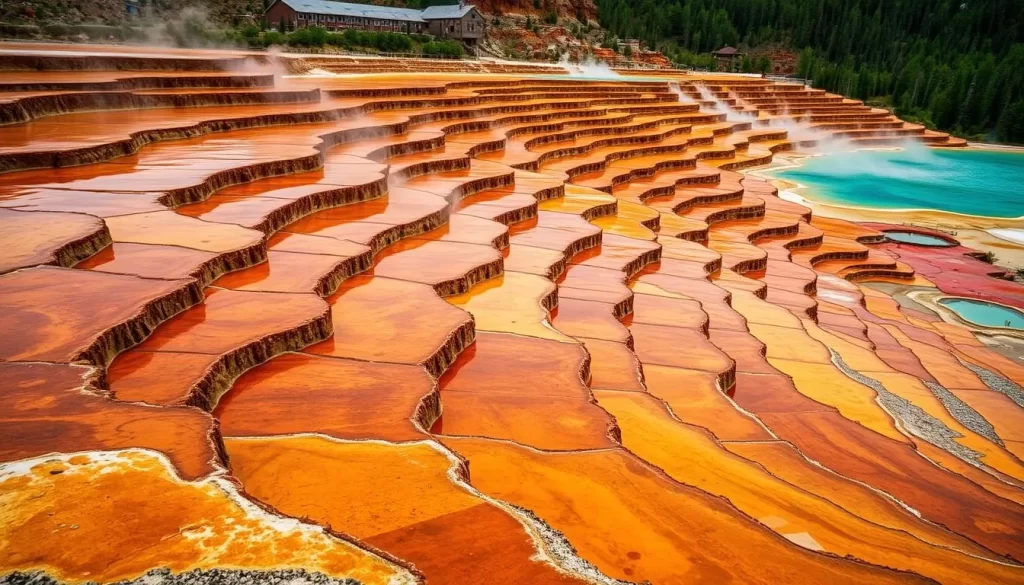
As one of Yellowstone’s most fascinating attractions, Mammoth Hot Springs offers an unforgettable experience. Located in the northern part of Yellowstone National Park, this large complex of hot springs is a must-visit destination, featuring an intricate network of travertine terraces.
Upper and Lower Terraces
The Mammoth Hot Springs area is characterized by its unique geothermal features, particularly the Upper and Lower Terraces. The Lower Terraces are accessible via a boardwalk system that guides you through remarkable formations like Liberty Cap, Palette Spring, and Minerva Terrace. Each of these formations displays unique shapes and textures, created by the continuous flow of hot water.
The Upper Terraces, on the other hand, can be explored through a combination of boardwalks and a scenic one-way driving loop. Highlights include Orange Spring Mound and Canary Spring, showcasing the diverse thermal features of the area.
Historic Fort Yellowstone
Adjacent to the Mammoth Hot Springs terraces lies the historic Fort Yellowstone, which served as the U.S. Army headquarters during their administration of the park from 1886 to 1918. Visitors can explore the Albright Visitor Center, housed in one of the original fort buildings, to gain insights into the park’s history and the development of the National Park Service.
The Mammoth area is also notable for its year-round elk population, often seen on the parade grounds of the historic fort. For the best experience, plan your visit during early morning or late afternoon to avoid crowds and capture the terraces in the best light for photography.
Yellowstone Lake and West Thumb Geyser Basin
The majestic Yellowstone Lake, accompanied by the geothermal marvels of West Thumb Geyser Basin, forms an unforgettable experience. As the largest high-elevation lake in North America, covering 136 square miles at an elevation of 7,733 feet, Yellowstone Lake boasts a fascinating underwater landscape of geothermal features.
Exploring America’s Largest High-Elevation Lake
Yellowstone Lake is not just a body of water; it’s a geological wonder. As part of the Yellowstone Caldera, the lake’s shoreline is dynamic, with portions rising and falling due to the movement of magma beneath the surface. The lake’s water temperature is too low for swimming without risking hypothermia, but it offers various ways to experience its beauty, including scenic drives along the shoreline and boat tours from Bridge Bay Marina.
- Scenic drives along the lake’s shoreline
- Boat tours from Bridge Bay Marina
- Fishing opportunities with proper permits
West Thumb Geyser Basin Highlights
The West Thumb Geyser Basin is a unique geothermal area where hot springs and geysers meet the lakeshore, creating a striking contrast between the deep blue lake and colorful hot springs. Abyss Pool, a deep blue pool that plunges to 53 feet with temperatures reaching 170°F, is one of the basin’s most impressive features.
Abyss Pool
Abyss Pool is the deepest hydrothermal pool in Yellowstone National Park, making it a must-see. Its deep blue color and extreme depth make it a fascinating sight.
Lakeside Geothermal Features
The basin also features Fishing Cone and Black Pool, where historical visitors once caught fish and cooked them in the same spot, and a pool with intense blue coloration, respectively.
Kayaking on Yellowstone Lake
For the adventurous, kayaking on Yellowstone Lake offers a unique perspective. Rental locations are available, and day paddlers can enjoy recommended routes while being mindful of sudden weather changes.
Hidden Gems and Lesser-Known Attractions
For those willing to venture off the beaten path, Yellowstone reveals a treasure trove of lesser-known wonders. While the park’s famous attractions draw millions, there are numerous hidden gems that offer equally impressive experiences with significantly fewer crowds.
Norris Geyser Basin
The Norris Geyser Basin is one of Yellowstone’s most fascinating thermal areas, boasting nearly 3 miles of boardwalks and trails that guide you through the Black Sand and Porcelain Basins. As the hottest and most dynamic thermal area in the park, it features the world’s tallest active geyser, Steamboat Geyser, along with the distinct Porcelain and Back Basin areas.
This area is a must-visit for anyone interested in geothermal features. The varied landscapes and unique geological formations make it a captivating experience, distinct from the more crowded areas of the park.
Artists’ Paintpots
Located in east Yellowstone, Artists’ Paintpots is a delightful thermal area that offers a more intimate experience than the park’s larger geyser basins. The easy, 1-mile loop trail takes you through a serene forest and into a vibrant display of colorful mud pots that bubble and splatter like an artist’s palette.
Blacktail Plateau Drive
Blacktail Plateau Drive is a lightly-trafficked, 7-mile one-way scenic drive that runs parallel to the Grand Loop Road between Mammoth and Tower. This unpaved road offers a peaceful alternative to the main route, with excellent opportunities to spot wildlife such as bison, elk, and potentially bears amidst the beautiful scenery.
Trout Lake Hike
The short Trout Lake Hike, a 1.2-mile round trip, is one of the best effort-to-reward ratios in the park. The trail leads to a picturesque lake with beautiful mountain reflections and potential sightings of cutthroat trout, making it a serene and rewarding experience.
Other overlooked attractions worth exploring include Sheepeater Cliff with its unique columnar basalt formations, Natural Bridge, and the Mud Volcano area. When planning your visit to these lesser-known spots, be sure to check for seasonal closures and vehicle restrictions to make the most of your Yellowstone adventure.
Unique Yellowstone Experiences
Yellowstone National Park is not just a destination; it’s an opportunity to immerse yourself in unique experiences that foster a deeper connection with nature and its rich history.
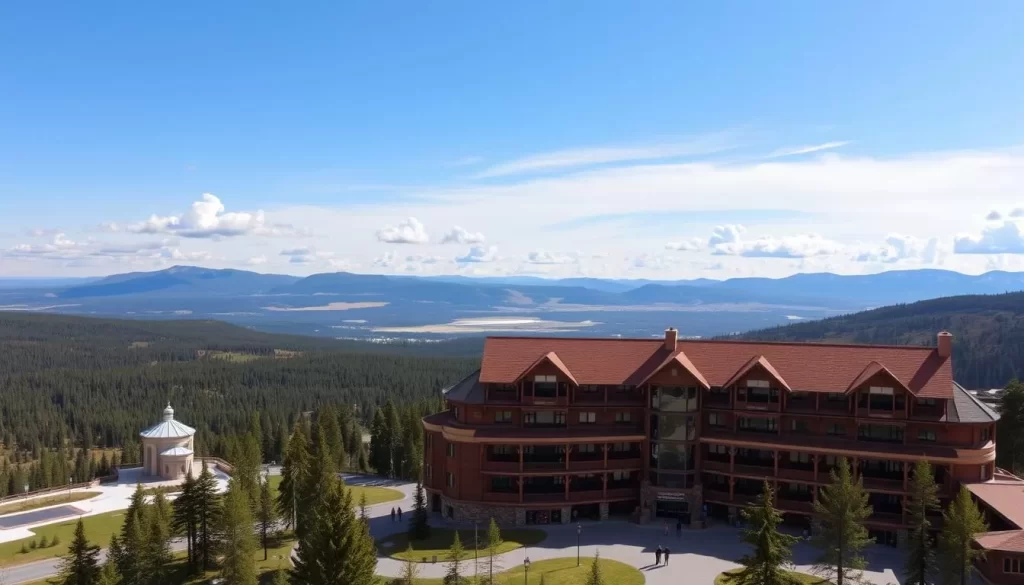
Crow’s Nest Tour at Old Faithful Inn
The Crow’s Nest Tour at Old Faithful Inn offers an exclusive experience, granting access to the historic crow’s nest lookout in the inn’s massive lobby. This rare perspective allows visitors to appreciate the interior architecture and witness Old Faithful eruptions in a unique way.
To secure a spot on this limited tour, which is only offered twice daily during summer months, planning ahead is essential. This experience is a must for those seeking to explore beyond the standard Yellowstone National Park itinerary.
Million Dollar Room (Hamilton Tour)
The Million Dollar Room, also known as the Hamilton Tour, is a fascinating experience that showcases the private apartment of Harry Child, the original financier of the Old Faithful Inn. This tour provides a glimpse into Yellowstone’s history and is a unique opportunity to explore the lesser-known aspects of the park.
Unlike the Crow’s Nest Tour, the Million Dollar Room tour does not require advanced planning, making it an accessible experience for visitors. However, its exclusivity lies in its lesser-known status among park visitors.
Private Fishing Guide Experience
For those interested in exploring Yellowstone National Park’s aquatic ecosystems, a private fishing guide experience offers a unique opportunity. This guided tour provides access to prime fishing spots while educating participants on the park’s conservation efforts.
The best season for this experience is typically from July to September, with a catch-and-release policy in place for native cutthroat trout. This ensures a sustainable and enjoyable experience for all participants.
In addition to these experiences, Yellowstone offers other unique activities such as the Yellowstone Institute field seminars, wolf tracking expeditions, and photography workshops. These expert-led immersive learning experiences create lasting memories and deepen one’s appreciation for the park’s natural and cultural heritage.
Best Scenic Drives Through Yellowstone
One of the best ways to explore Yellowstone is through its scenic drives, which cater to various interests and mobility needs. The park offers several drives that showcase its diverse landscapes and thermal features.
Firehole Canyon Drive
Firehole Canyon Drive is a 2-mile one-way detour that follows the Firehole River through a dramatic canyon. As you drive through, look up at the canyon walls for wildlife such as elk. Stop at Firehole Falls to take a photo. Further down the road, there’s a swimming area, although it has been closed in recent years due to COVID. The geyser-fed Firehole River maintains a warm temperature, making it ideal for swimming.
Dunraven Pass
For stunning views of the park, drive over Dunraven Pass, the highest road in Yellowstone at 8,859 feet. This drive connects Tower-Roosevelt and Canyon Village, offering spectacular mountain views and wildlife viewing opportunities. There are numerous overlooks and turnouts where you can stop and enjoy the panoramic vistas of the Absaroka Range.
Firehole Lake Loop
The Firehole Lake Road is a 3-mile, one-way drive off the Grand Loop between Old Faithful and Madison. This drive provides access to several impressive geysers and hot springs visible from the road and boardwalk. Great Fountain Geyser is a highlight, erupting every 9-15 hours and is particularly beautiful at sunset.
| Scenic Drive | Highlights | Distance |
|---|---|---|
| Firehole Canyon Drive | Firehole Falls, wildlife viewing | 2 miles |
| Dunraven Pass | Panoramic views, wildlife | Varies |
| Firehole Lake Loop | Geysers, hot springs | 3 miles |
When driving through Yellowstone, be mindful of wildlife, follow parking etiquette at popular viewpoints, and maintain safe speeds on the park’s winding roads.
Where to Stay in Yellowstone
When planning your trip to Yellowstone National Park, choosing the right place to stay is crucial for a comfortable and enjoyable experience. The park offers various accommodation options, ranging from historic lodges to campgrounds and nearby towns.
Historic Lodges and Hotels
For a luxurious experience, consider staying at one of Yellowstone’s historic lodges. Old Faithful Inn is a standout choice, known for its massive log construction and 76-foot ceiling in the lobby. It’s located next to the famous Old Faithful geyser, making it an ideal base for your adventures.
Old Faithful Inn
Due to its popularity, it’s essential to book Old Faithful Inn 12-18 months in advance. The inn offers various room categories, including those with and without private bathrooms.
Lake Lodge and Cabins
For a more peaceful experience, Lake Lodge and Cabins is a great alternative. Located on the shores of Yellowstone Lake, it offers beautiful lake views and a central location for exploring the eastern part of the park.
Campgrounds Within the Park
If you prefer camping, Yellowstone has several well-managed campgrounds. The park has five campgrounds that accept reservations: Bridge Bay, Canyon, Fishing Bridge RV Park, Grant Village, and Madison. There are also seven first-come, first-served options. Costs range from $25-$32 per night for standard sites.
Nearby Towns for Accommodation
If you’re unable to secure accommodations within the park, consider staying in nearby towns like West Yellowstone. These gateway communities offer a range of accommodation options and are relatively close to major attractions.
Seasonal Activities and Attractions
The beauty of Yellowstone National Park lies in its seasonal transformations, which bring distinct experiences and activities to the park throughout the year. Whether you’re visiting in the peak of summer or the tranquility of winter, Yellowstone has something to offer.
Summer Highlights
Summer is the peak season in Yellowstone, with all roads and facilities open, and longer daylight hours for exploration. You can enjoy the fullest range of ranger programs and activities, making it an ideal time for families and adventure seekers. However, this is also the busiest time, with larger crowds and higher accommodation rates, so advance planning is essential.
- Explore the park’s vast wilderness on hiking trails
- Participate in ranger-led programs and activities
- Enjoy water activities on Yellowstone Lake
Fall Colors and Wildlife
Fall (September-October) is a magical time to visit Yellowstone, with the aspens turning golden, bugling elk during the rut, and fewer crowds. The comfortable daytime temperatures make it ideal for hiking and wildlife viewing. It’s a great time to see wildlife in their natural habitats.
- Witness the elk rut and other wildlife behaviors
- Enjoy the scenic beauty of golden aspens
- Take advantage of fewer crowds for a more serene experience
Winter Wonderland Experiences
Winter transforms Yellowstone into a snow-covered wonderland, accessible primarily by snowcoach or snowmobile tours. The steaming thermal features against snowy backgrounds, frost-covered bison, and the surreal experience of seeing Old Faithful erupt in the snow make it a unique experience.
- Explore the park on snowcoach or snowmobile tours
- Witness the thermal features in a snowy landscape
- See wildlife adapted to the winter conditions
Relaxation Spots: Hot Springs and Swimming Areas
Unwind and rejuvenate in the natural hot springs and swimming areas that Yellowstone National Park has to offer. After a day of hiking and sightseeing, these spots provide a welcome respite.
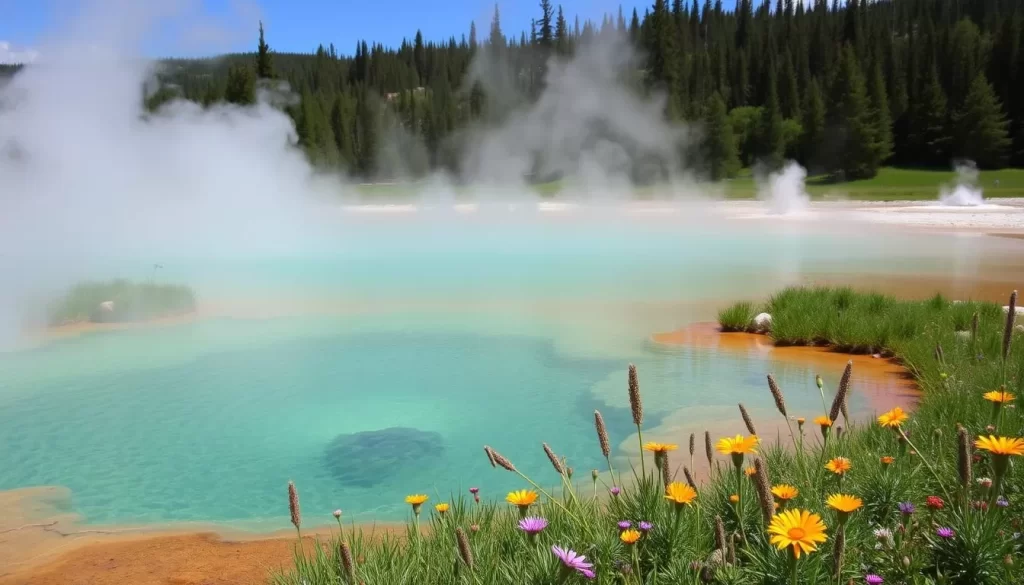
Boiling River Hot Spring
Located between Mammoth Hot Springs and the North Entrance, Boiling River Hot Spring is a naturally occurring hot spring where hot thermal water mixes with the cold Gardner River, creating perfect soaking temperatures. To get there, park at one of the two parking lots on North Entrance Road and take a flat, half-mile walk.
It’s essential to check the current conditions before visiting, as the spring is subject to closure due to water levels or maintenance. Typically, it opens after the 4th of July due to high water during spring runoff.
Firehole Swimming Area
The Firehole Swimming Area is a popular summer destination, where the geothermally heated Firehole River creates a natural swimming hole with comfortable water temperatures. Located 2 miles south of Madison Junction on Firehole Canyon Drive, it offers a unique swimming experience.
Visitors should be aware of the safety considerations and facilities available. As with any natural water body, checking the current conditions before visiting is crucial.
When visiting these relaxation spots, it’s crucial to follow proper etiquette: avoid using soap or other contaminants, respect other visitors, and adhere to all posted regulations to preserve these natural wonders.
Conclusion: Planning Your Perfect Yellowstone Adventure
From geysers to wildlife, Yellowstone National Park offers an unparalleled experience. As America’s first national park, it continues to inspire wonder and awe in visitors from around the world.
When planning your trip to Yellowstone, it’s essential to consider the time of visit to avoid the crowds. With so many things to see and do, you should make sure to allocate enough time for your trip. A minimum of 4-5 days is recommended to explore the park’s diverse attractions.
The park’s diverse landscapes and wildlife make it a unique destination. You can witness the famous Old Faithful eruption, explore the Grand Prismatic Spring, and enjoy wildlife viewing opportunities in Lamar Valley and Hayden Valley. To make sure you don’t miss out on the best experiences, plan your itinerary in advance.
To enhance your visit, consider participating in ranger programs and visiting the visitor center exhibits. These resources will help you deepen your understanding of the park’s natural and cultural significance. Additionally, be mindful of responsible tourism practices, such as staying on designated trails and proper waste disposal, to help preserve the park for future generations.
As you embark on your Yellowstone National Park adventure, remember to be flexible and open to unexpected discoveries. With its rich history, stunning landscapes, and diverse wildlife, Yellowstone is a destination that will leave you with unforgettable memories. So, start planning your trip today and experience the wonders of Yellowstone National Park for yourself.
The above is subject to change.
Check back often to TRAVEL.COM for the latest travel tips and deals.
